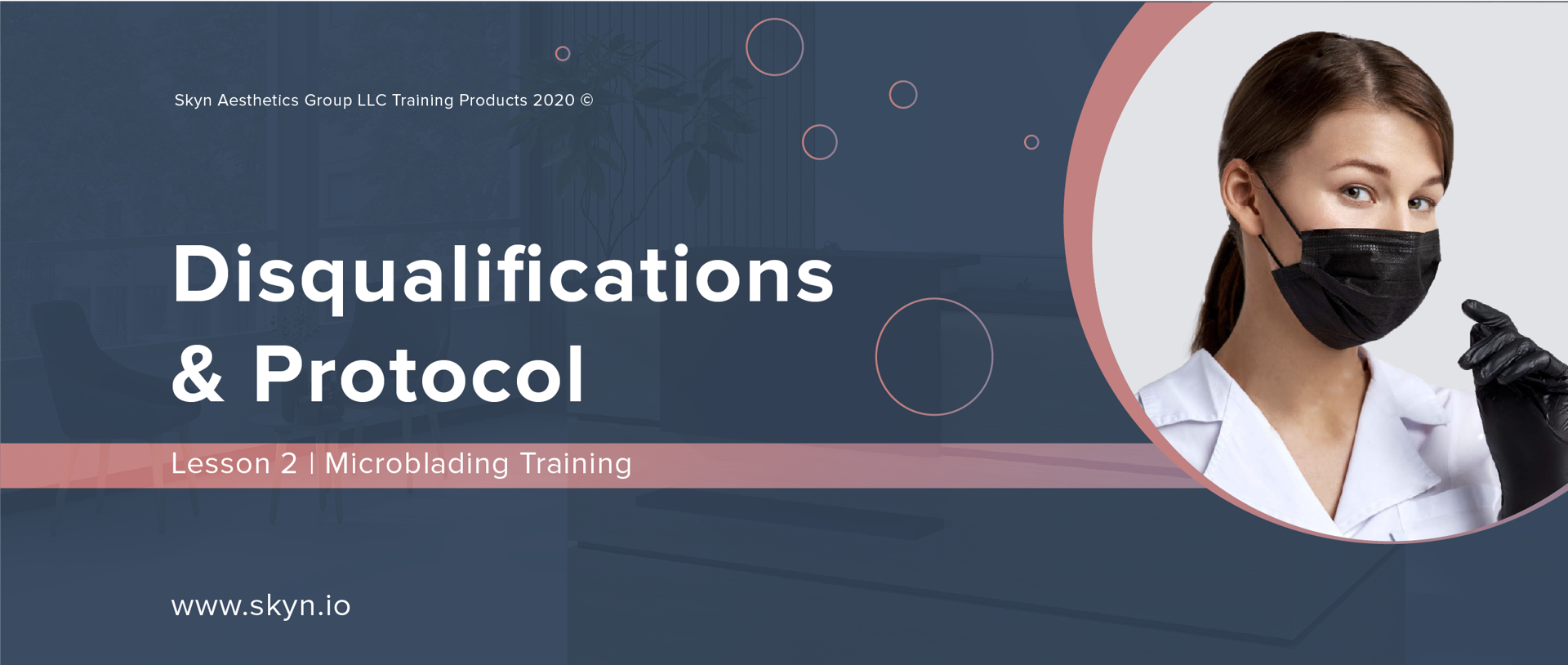

Disqualifications & Contraindications
When consulting with your client you may encounter disqualifications or contraindications that may prevent you from administering treatment. Contraindications are any conditions your clients might have that would prohibit you from proceeding with their requested treatment. If your client has any of these conditions, the only way you can proceed is if you receive written confirmation from their General Practitioner with permission to move forward. This is a protection for you and the client. If your client is unsure about any health condition, consulting with their doctor before the treatment is the best course of action.
Ask and document all health conditions and compare with the list on your client intake form. If you move ahead with treatment knowing that they have a contraindication, it could potentially worsen their condition. Below are some common health problems that are possible contraindications for the Microblading treatment.
• Cancer
• Immune Disorder
• AIDS/HIV
• High/Low Blood Pressure
• Pregnancy
• Spinal Injury
• Keloid Scarring
• Menopause
• Hysterectomy
• Claustrophobia
• No one 21 and younger
• Pacemaker/Defibrillator
• Cold Sores
• Blood Clot Disorder
• Varicose
• Blush/Redden Easily
• Veins/Phlebitis
• Any Active Infection
• Headaches
• Eczema
• Diabetes
• Skin Disease/Disorder
• Circulation Disorder
• Heart Disease
• Hepatitis A/B/C
• Thyroid Disorder
• Metal Implants/Pins
• Depression/Anxiety
• Bruise Easily
• Lupus
• Fibromyalgia
• Hormone Imbalance
• Alcohol or Drug Abuse
• Psoriasis
• Recent Dermal Injections/Fillers
• Epilepsy/Seizures
• Use of oral or topical Roaccutane or Retin-A, vitamin A or other such products in the previous 3 months for the treatment of acne or other dermatological conditions
In order to determine a client's needs and identify contraindications, an accurate inspection of the skin is crucial. The treatments are categorized into those that require medical referral and those that are restricted to the local area.
Infectious skin disorders and diseases are the most common conditions that require medical referral.
WHAT YOU WILL LEARN
LESSON 2
Disqualifications & Protocol
Screen
If you advise your potential clients as to whether they're candidates for microblading prior to their appointment, you'll save yourself and them a lot of trouble and frustration. Conduct consultations prior to the first appointment. The reason is that appointments can be very long and thorough, you may spend most of the time talking to clients and designing their eyebrows. Therefore, screening would be the only reason for a consultation. Advise your clients on who is a candidate.
Who Is A Candidate?
It's anyone who wants beautiful, full brows all day, every day! The target audience includes busy parents and business people who have little time to apply their brow makeup, active people who don't want to worry about sweaty makeup while exercising or swimming, or anyone who has trouble getting those perfect brows that celebrities and YouTube makeup artists always seem to have. Patients with scarring, trichotillomania, alopecia, cancer, and other diseases and disorders that result in natural hair loss are also treated.
Some Reasons for non-candidates
Taking Blood Thinners : This increases bleeding and makes it harder to perform the procedure. The pigment can also become diluted, resulting in a splotchy appearance.
Inflammation Of The Skin Near The Treatment Area, Such As Sunburn Or Eczema: Skin that has been inflamed will be extremely sensitive and will have poor results.
Use Of Skin Sensitizing Products : (including but not limited to Retinol/Retin-a/Vitamin A - should be stopped two weeks prior to the appointment) Product and medication sensitivity can lead to bleeding and long healing, resulting in poor customer service and poor results.
Botox Within The Last Two Weeks : Botox can alter the symmetry of your eyebrows. If you plan on getting Botox before microblading, then wait until it has fully kicked in.
Accutane within last year : This can affect skin sensitivity and healing as well as lead to changes in skin condition, impacting healing.
History Of Keloid Scarring : Microblading involves very small cuts, so there is a possibility that those cuts could result in keloid scarring.
Undergoing Chemotherapy: People who are undergoing chemotherapy may suffer from poor healing. In addition, any tattoo poses a risk of infection, and risking someone's health is not worth it for someone battling cancer.
Acne Sufferers : During microblading sessions, breakouts of acne in the brow could cause bleeding, which would dilute the pigment and may also cause spotty healing.
Pregnant Women : There is a general recommendation to wait for microblading until after delivery as a precaution for the unborn child.
Client Care
When An Initial Consultation Is Needed
• If they had previously applied permanent makeup to their eyebrows
• Very oily skin
• Poor healing history
• If you want to avoid misunderstandings or wasted time, screen your candidates via email, text, or online.
Educate
The truth is so many people are still learning about microblading, despite the fact that it may seem like everyone knows how it works. On the internet, as well as among friends and industry professionals, there is a lot of inaccurate information. You likely know a lot more about this craft than your potential clients, so it is crucial that you make sure they understand it all completely. Your clients will not only be impressed with your level of expertise, but also you will save yourself from a lot of headaches if they know exactly what to expect before you meet them.
Client Preparation
It may be necessary for your client to follow certain procedures before treatment.
When preparing for treatment, as well as during and after treatment, special consideration should be given to tasks involved.
Client Preparation
• Botox can alter your eyebrow's position, so you should get it at least two weeks prior to your appointment.
• At least two weeks before treatment, stop using Vitamin A/Retinol products.
• One week before treatment, stop taking Fish Oil or Vitamin E.
• Ask for any questions you have about the forms you will receive at the time of your appointment. Read all the forms thoroughly.
• Before your appointment, please let us know if you have any allergies, medical conditions, previous permanent eyebrow makeup or prescriptions.
• It is impossible to know and understand all the medications, products and supplements available on the market. For any questions on what's best for your client, refer them to their medical professional when in doubt using this list as a handy reference.
Preparing For Treatments
It is essential to prepare before beginning any treatment in order to ensure that health and safety precautions have been taken. The treatment area should never show evidence of the previous client, such as crumpled bed sheets or used towels.
Questioning
Speaking clearly, asking only appropriate questions, listening carefully to what the client is saying, and showing respect are all part of demonstrating professionalism. When you conduct the consultation in a professional manner, the client will feel confident and trust you. Provide time for questions from the client. Creating a relaxed atmosphere for your clients is important.
Questioning Techniques
• Empathize and understand.
• To gain information, ask as many open-ended questions as you can. Do not ask more than what is necessary. Both open-ended and closed questions are appropriate.
open And closed Questions
Closed question : How often do you cleanse your skin?
Open question : Are you taking any medications, and if so, what condition is it for?
Closed question : What medications do you take?
remember:
Not all clients are suitable for eyebrow tattooing.
Skin Condition
How To Tattoo
• Can tattoo normally
• Pigment lasts longer
• Severely Oily
• Choose an ink color that is a little darker than necessary, as ink on this skin type will fade more quickly
• Big Pores
• Warmer color is ideal
• Rosacea
• They have fair skin, gently go over bumps, and avoid bleeding; microneedling not recommended otherwise
• Sun Damaged
• Sun spots and freckles may be indicators that skin has been sun damaged
• After one week, they should begin putting sunscreen directly on top of their new brows to protect them from fading.
• Acne and Pimples
• Do not pop - may cause infection
• Mole
• Do not touch moles when Microblading
• Mature Pronounced Wrinkles
• Choose an ink color that is slightly lighter
• Healthier, mature skin will absorb color so the tattoo will appear darker
• Mature skin may be thinner, tougher, more dry, and higher risk of scarring.
• Avoid bleeding

precautions & protocols
Ask and document all health conditions and compare with the list on your client intake form. If you move ahead with treatment knowing that they have a contraindication, it could potentially worsen their condition. Below are some common health problems that are possible contraindications for the Ombré Brow treatment.
additional considerations
Oily skin or large pores can make tattooing more difficult. You may need more than one required touch up. Make sure your client understands that oily skin or large pores may cause pigment to expand so they are better candidates for ombré brows vs microblading.
Questions To Ask Over Phone:
- What kind of brow makeup do you wear? What color and how much do they typically wear?
LESSON 2 RECAP
Let's go over everything we have learned in this lesson. It's valuable to review the highlights of the recently absorbed information to help new knowledge stick. We hope you're enjoying the course so far and we'll see you in the next lesson.
What are disqualifications and contraindications?
Disqualifications and contraindication are reasons why your client would be unable to have a procedure performed.
What are some examples of disqualifications?
There are many possible health issues that you should consider. We recommend printing a list of contraindications for your records. A few examples would be Hepatitis A/B/C, AIDS/HIV, pregnancy, or cold sores to name a few.
If a client has a contraindication, how can they be allowed to have the procedures done?
When your clients inform you of a contraindication, they can have it done only if they receive a letter from their general practitioner stating it is okay.
No, not everyone is suitable. You need to consider their skin conditions, disqualification, and contradictions.
• Acne and Pimples: Avoid tattooing through and do not pop; may cause infection
• Moles: Work around moles do not touch
• Mature, Pronounced Wrinkles: choose a lighter ink, mature skin absorbs color so it appears darker; skin may be thinner, tougher, or drier with higher risk of scarring; avoid bleeding
How to handle less common skin conditions:
• Big pores/Severely oily/Capillaries/Severely dry/Severely flaky: chose warmer ink for big pore, chose darker colors since this skin will fade quicker
• Rosacea: clients have fair skin, gently go over bumps, and avoid bleeding
• Sun Damage: sun spots and freckles maybe indicators of sun damage, evaluate if skin is safe to work on, expect heavy bleeding, and be careful not to irritate.
any Questions?
Please email us at edu@skyn.io | It may take up to 48 hours to reply